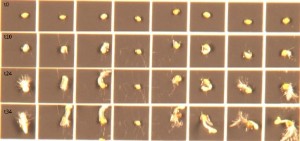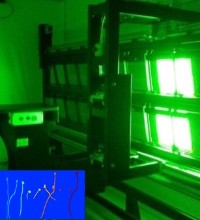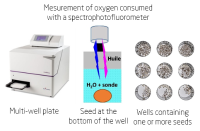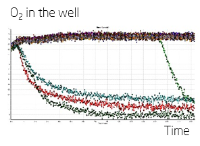Measurement of germinative quality and seedling growth
Measurements under optimum or penalizing controlled conditions of:
- temperature,
- hygrometry,
- light
 Sylvie Ducourneau
Sylvie Ducourneau
sylvie.ducourneau @ geves.fr
|
Automated monitoring of imbibition and germination rates on sprout beds Multicam® |
Automated monitoring of seedling growth under heterotrophic conditions on ElonCam |
Explore natural genetic diversity to identify physiological traits of interest under different temperature conditions.

![]() This allowed for example to identify QTL that specifically control the rates of imbibition, germination and growth of the embryonic axis.
This allowed for example to identify QTL that specifically control the rates of imbibition, germination and growth of the embryonic axis.
Potential benefit:
Assist breeders in obtaining leguminous plants able to sprout under penalizing growing conditions (deep sowing in arid zones, sowing under cold conditions).
 Beatrice Teulat
Beatrice Teulat
beatrice.teulat @ agrocampus-ouest.fr
Identify genes involved in the regulation of phenotypic plasticity of germinative quality.
Reguleg project (2016-2019) – funded by ANR
Seeds of 200 genotypes of truncated alfalfa, produced under optimum conditions and under water deficiency, were screened to identify plastid loci by a genome-wide association (GWAS).
Potential benefit:
Produce legume varieties that are better adapted to climate change.
 Julia Buitink
Julia Buitink
julia.buitink @ inra.fr
To study the interactions between seeds and phytopathogenic agents during germination and seedling emergence.
 Patharaseed project (2014-2016) –funded by Angers University
Patharaseed project (2014-2016) –funded by Angers University
associated with the thesis of Elodie Belmas (2014-2017)
Potential benefit:
Develop more effective treatment products at lower doses, identify disease-resistant varieties.

 Phlippe Grappin
Phlippe Grappin
philippe.grappin @ agrocampus-ouest.fr
Measurement of seed metabolism
The O2 consumption curves show the heterogeneity of the imbibition rates of the seed lots.
Outlook:
Use respiratory activity measurements as an indicator of the vigour and homogeneity of a seed lot.
|
|
|
 David Macherel
David Macherel
david.macherel@univ-angers.fr
A simple and innovative method for high-throughput seedling phenotyping
Phenotyping of seedlings in multi-well plates in a non-sterile medium
- An ideal method for evaluating the impact of abiotic stresses (temperature, salt stress, osmotic ...) on seedling germination and survival of the seedlings.

- Use in the framework of the ACCLIMHOT project including the thesis of Elise Réthoré – funded by RFI Objectif Végétal
With Evian water, no contamination or agglutination of A. thaliana after several weeks of culture.
→ High through-put phenotyping of the quantity of chlorophyll by simple digital image analysis.
Potential benefit:
By this method, screen high-throughput molecules for inhibitory / protective effects under abiotic stress conditions.
 David Macherel
David Macherel
david.macherel @ univ-angers.fr
Phenotyping of the ability of seeds to conserve
- Phenotyping of seed viability under controlled aging conditions to determine longevity of batches
- Different measures of deterioration of seed vigour to accurately predict the quality
- Use of modeling to estimate seed ability to conserve
Use in projects:
- REGULONG (2014-2017) – funded by RFI Objectif Végétal. Identification of key regulator of seed longevity.
- REGULEG (2016-2018) – funded by ANR. Identification of key regulators of legume seeds adaptation to environmental fluctuations
Potential benefit:
Propose solutions for the conservation of genetic resources or carry-over lots.
 Olivier Leprince
Olivier Leprince
olivier.leprince@agrocampus-ouest.fr
Contacts
Looking for partners?
Two contacts to support your projects:
- Aurore Gautier,
 contact to support your R&D projects land to put you through
contact to support your R&D projects land to put you through
aurore.gauthier @ vegepolys.eu
- Tanegmart Redjala,
 close interface with the laboratories of the Research Federative Structure Quasav.
close interface with the laboratories of the Research Federative Structure Quasav.







